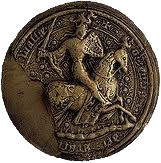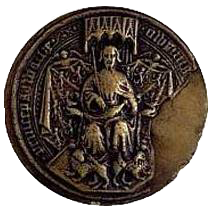Who Was Owain Glyn Dŵr?
Soldier Diplomat Statesman

We believe Owain ap Gruffydd Fychan was born in 1359. As a young man he studied Law in London, and served with the Earl of Arundel in Richard II’s campaigns in Scotland and Ireland. He owned estates at Sycharth (near Oswestry) and Glyndyfrdwy (near Corwen) and in south west Wales.
Poets from the ninth century onwards had protested against oppression of the Welsh, and predicted the coming of a Mab Darogan ('Son of Prophesy') who would free the nation. The Welsh saw Glyn Dŵr as the man to lead the nation in its fight for freedom.
The Welsh suffered from harsh laws, which led to resentment against the crown. This reached its critical point on September 16th. 1400 when over 300 of Owain’s supporters met at Glyndyfrdwy to proclaim him Prince of Wales. The sacking of the towns of Ruthin, Denbigh, Rhuddlan, Flint, Hawarden, Oswestry and Welshpool followed. In response, Henry IV’s army marched into north Wales.
1401 saw the defeat of an army of English and Flemish at Hyddgen; Henry IV launched a campaign into south Wales and harsh new laws were imposed on the Welsh. In 1402 Owain’s men gained a famous victory over the army of Edmund Mortimer at Brynglas (Pilleth) and by 1404 Owain’s campaign was approaching its high point. He captured Harlech and Aberystwyth castles and called a parliament at Machynlleth.
In 1405 Owain signed an agreement with Thomas Percy of Northumberland and Edmund Mortimer to divide the kingdom in three parts (the Tripartite Indenture). Wales’ border would extend as far as the Severn, to Six Ashes (10 miles from Birmingham), and the sources of the Trent, and Mersey. Owain’s men campaigned into England getting to within a few miles of Worcester.
In 1406 a letter was sent to the king of France (the Pennal Letter). In it he outlined his ambitions for an independent church for Wales, and two universities - one for north Wales and one for south Wales, but by 1408 Owain’s campaign was in decline and the castles of Aberystwyth and Harlech (home of Owain’s court) were lost. When Harlech castle fell, several members of his family were captured and sent to the Tower of London. Some sources suggest he probably died in 1415. His last years are shrouded in mystery and we have no conclusive evidence of where he is buried.

Glyn Dŵr’s Great Seal







